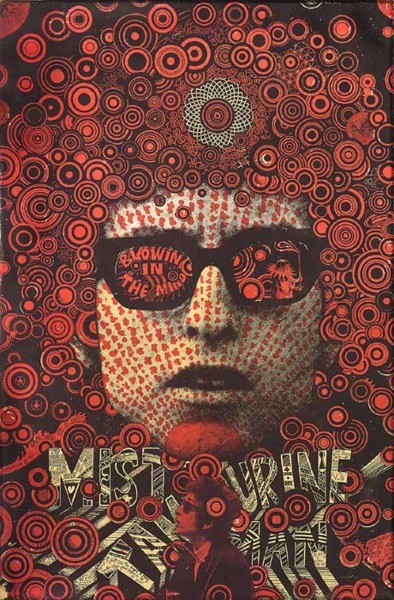Donations to the German Poster Museum (2005-2011)
12 Nov 2011 - 22 Jan 2012

Martin Ritchie Sharp
Blowing in the Mind Mister Tambourine Man, 1967
Großbritannien
Schenkung Richard Hubertus Spelberg 2008
Blowing in the Mind Mister Tambourine Man, 1967
Großbritannien
Schenkung Richard Hubertus Spelberg 2008
DONATIONS TO THE GERMAN POSTER MUSEUM (2005-2011)
12 November, 2011- 22 January, 2012
Like for every museum, a major task for the German Poster Museum is an extension of its collection with significant works, and this is done in different ways. The main possibilities are acquisition, exchange and donations.
This exhibition will take up the donations the German Poster Museum has received since 2005 and thus publically thank the donors of posters an of funds for acquisitions of mostly special individual works.
These donations to the museum are insignificant neither in quality nor in quality. With posters, the decisive point is often not the financial value; very often there are emotional reasons why such a collection was put together. They are generally grouped around a topic or a designer. The willingness to give these works to us is therefore to be honored all the more. Here we are taking up the idea of the exhibition In Trustworthy Hands – Donations to the German Poster Museum from 1996.
The reasons for donating posters to the German Poster Museum may vary, but the expectations remain the same: the work should be well conserved, should be dealt with, should be available to the public and the name of the donor shouldn’t be forgotten. And indeed, the exhibitions by the German Poster Museum in the Museum Folkwang organized since 2005 would not have been possible without these donations, at least not with the same quality. Thus the taking becomes a giving, this is our duty which we wish to fulfil and show that the donations do not simply disappear into the depths of the storeroom, but that they are valued, also beyond the exhibitions – through an intensive formal and scholarly study of them.
The exhibition will show around 60 posters selected from the ca 12,500 works donated to the museum made between 1910 an today; geographically they come mostly from Europe, with the majority of those from Germany.
Even if this can only provide a brief insight, this presentation is naturally also intended to encourage, to persuade the hesitant to give their posters to the German Poster Museum or to support an acquisition.
12 November, 2011- 22 January, 2012
Like for every museum, a major task for the German Poster Museum is an extension of its collection with significant works, and this is done in different ways. The main possibilities are acquisition, exchange and donations.
This exhibition will take up the donations the German Poster Museum has received since 2005 and thus publically thank the donors of posters an of funds for acquisitions of mostly special individual works.
These donations to the museum are insignificant neither in quality nor in quality. With posters, the decisive point is often not the financial value; very often there are emotional reasons why such a collection was put together. They are generally grouped around a topic or a designer. The willingness to give these works to us is therefore to be honored all the more. Here we are taking up the idea of the exhibition In Trustworthy Hands – Donations to the German Poster Museum from 1996.
The reasons for donating posters to the German Poster Museum may vary, but the expectations remain the same: the work should be well conserved, should be dealt with, should be available to the public and the name of the donor shouldn’t be forgotten. And indeed, the exhibitions by the German Poster Museum in the Museum Folkwang organized since 2005 would not have been possible without these donations, at least not with the same quality. Thus the taking becomes a giving, this is our duty which we wish to fulfil and show that the donations do not simply disappear into the depths of the storeroom, but that they are valued, also beyond the exhibitions – through an intensive formal and scholarly study of them.
The exhibition will show around 60 posters selected from the ca 12,500 works donated to the museum made between 1910 an today; geographically they come mostly from Europe, with the majority of those from Germany.
Even if this can only provide a brief insight, this presentation is naturally also intended to encourage, to persuade the hesitant to give their posters to the German Poster Museum or to support an acquisition.
